甲酸水合肼的还原方法
水合肼催化还原法制备4-氨基二苯胺

水合肼催化还原法制备4-氨基二苯胺程正载;龚凯;王洋;王从月;林素素;颜晓潮【摘要】以80%的水合肼为还原剂,Fe(OH)3/C为催化剂,还原4-硝基二苯胺得到4-氨基二苯胺,通过质谱和红外光谱表征了目标产物结构,通过液相色谱测定了产物纯度.较佳工艺条件为:4-硝基二苯胺用量0.05mol,Fe(OH)3负载量约5%的Fe(OH)3/C复合催化剂用量0.45g,水合肼5 mL,反应温度80℃,反应时间60 min,4-氨基二苯胺的收率可达98.4%.研究表明,以Fe(OH)3为主催化剂,酸处理过的活性炭为助剂,4-硝基二苯胺可被水合肼高效还原为4-氨基二苯胺,产品收率和纯度较高,工艺过程清洁环保.【期刊名称】《精细石油化工》【年(卷),期】2014(031)002【总页数】4页(P25-28)【关键词】4-硝基二苯胺;4-氨基二苯胺;催化还原;水合肼【作者】程正载;龚凯;王洋;王从月;林素素;颜晓潮【作者单位】武汉科技大学化工学院,湖北武汉430081;湖北省煤转化与新型炭材料重点实验室,湖北武汉430081;武汉科技大学化工学院,湖北武汉430081;武汉科技大学化工学院,湖北武汉430081;南加州大学化工系,美国洛杉矶CA90089;温州市环境保护局,浙江温州325027;武汉科技大学化工学院,湖北武汉430081;湖北省煤转化与新型炭材料重点实验室,湖北武汉430081【正文语种】中文【中图分类】TQ246.3+24-氨基二苯胺俗称RT培司,又称对氨基二苯胺,是一种重要的橡胶和纺织防老剂中间体,主要用于生产对苯二胺类橡胶防老剂4010、4010NA、4020和688等[1]。
4-氨基二苯胺常用的合成方法主要有苯胺法、甲酰苯胺法、硝基苯法和二苯胺法[2]。
4-氨基二苯胺大多数是由4-硝基二苯胺还原得到,而4-硝基二苯胺通常都由苯胺法或甲酰苯胺法制备;4-氨基二苯胺也可通过硝基苯法合成4-硝基二苯胺与4-亚硝基二苯胺的混合体系,再加氢还原制得。
水合肼反应后处理-概述说明以及解释
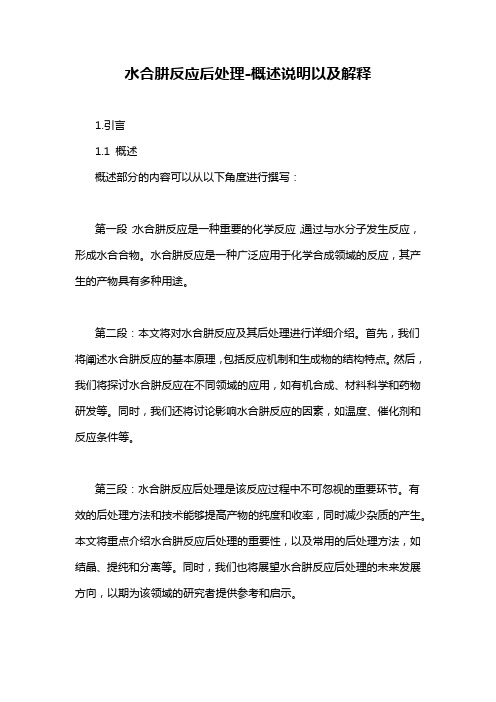
水合肼反应后处理-概述说明以及解释1.引言1.1 概述概述部分的内容可以从以下角度进行撰写:第一段:水合肼反应是一种重要的化学反应,通过与水分子发生反应,形成水合合物。
水合肼反应是一种广泛应用于化学合成领域的反应,其产生的产物具有多种用途。
第二段:本文将对水合肼反应及其后处理进行详细介绍。
首先,我们将阐述水合肼反应的基本原理,包括反应机制和生成物的结构特点。
然后,我们将探讨水合肼反应在不同领域的应用,如有机合成、材料科学和药物研发等。
同时,我们还将讨论影响水合肼反应的因素,如温度、催化剂和反应条件等。
第三段:水合肼反应后处理是该反应过程中不可忽视的重要环节。
有效的后处理方法和技术能够提高产物的纯度和收率,同时减少杂质的产生。
本文将重点介绍水合肼反应后处理的重要性,以及常用的后处理方法,如结晶、提纯和分离等。
同时,我们也将展望水合肼反应后处理的未来发展方向,以期为该领域的研究者提供参考和启示。
总结起来,本文将全面论述水合肼反应及其后处理的相关内容,旨在加深对该反应的理解和应用,为相关领域的科研工作者提供有益的知识和技术支持。
通过深入研究水合肼反应及其后处理,我们可以不断提升该反应的效率和产物的质量,推动相关领域的发展与创新。
1.2文章结构文章结构:本文将按照以下结构进行阐述水合肼反应后处理的内容:1. 引言1.1 概述:介绍水合肼反应及其在化学领域的重要性和广泛应用。
1.2 文章结构:详细说明文章的整体结构,包括正文和结论部分的内容安排。
1.3 目的:阐明本文旨在探讨水合肼反应后处理的重要性及其可能的未来发展方向。
2. 正文2.1 水合肼反应的基本原理:解释水合肼反应的基础知识,包括反应机理和关键步骤。
2.2 水合肼反应的应用领域:探讨水合肼反应在化学和相关领域的广泛应用,并举例说明其在合成和催化等方面的具体应用。
2.3 水合肼反应的影响因素:分析影响水合肼反应后处理效果的因素,包括反应条件、催化剂选择等,以及这些因素对反应结果的影响。
硝基化合物还原方法.
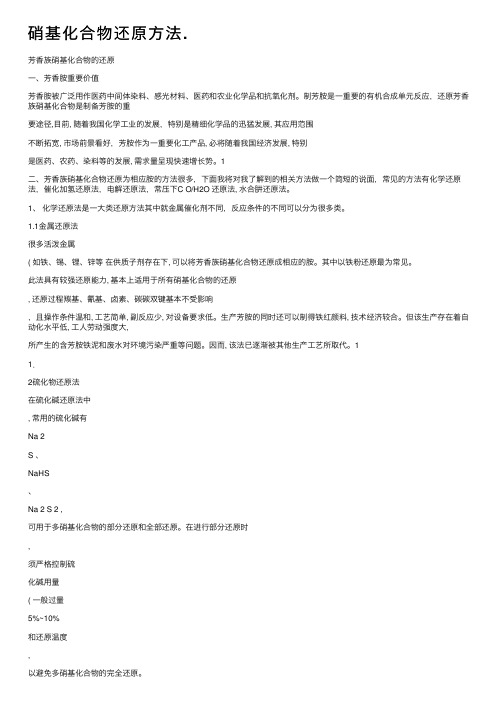
硝基化合物还原⽅法.芳⾹族硝基化合物的还原⼀、芳⾹胺重要价值芳⾹胺被⼴泛⽤作医药中间体染料、感光材料、医药和农业化学品和抗氧化剂。
制芳胺是⼀重要的有机合成单元反应,还原芳⾹族硝基化合物是制备芳胺的重要途径,⽬前, 随着我国化学⼯业的发展,特别是精细化学品的迅猛发展, 其应⽤范围不断拓宽, 市场前景看好,芳胺作为⼀重要化⼯产品, 必将随着我国经济发展, 特别是医药、农药、染料等的发展, 需求量呈现快速增长势。
1⼆、芳⾹族硝基化合物还原为相应胺的⽅法很多,下⾯我将对我了解到的相关⽅法做⼀个简短的说⾯,常见的⽅法有化学还原法,催化加氢还原法,电解还原法,常压下C O/H2O 还原法, ⽔合肼还原法。
1、化学还原法是⼀⼤类还原⽅法其中就⾦属催化剂不同,反应条件的不同可以分为很多类。
1.1⾦属还原法很多活泼⾦属( 如铁、锡、锂、锌等在供质⼦剂存在下, 可以将芳⾹族硝基化合物还原成相应的胺。
其中以铁粉还原最为常见。
此法具有较强还原能⼒, 基本上适⽤于所有硝基化合物的还原, 还原过程羰基、氰基、卤素、碳碳双键基本不受影响,且操作条件温和, ⼯艺简单, 副反应少, 对设备要求低。
⽣产芳胺的同时还可以制得铁红颜料, 技术经济较合。
但该⽣产存在着⾃动化⽔平低, ⼯⼈劳动强度⼤,所产⽣的含芳胺铁泥和废⽔对环境污染严重等问题。
因⽽, 该法已逐渐被其他⽣产⼯艺所取代。
11.2硫化物还原法在硫化碱还原法中, 常⽤的硫化碱有Na 2S 、NaHS、Na 2 S 2 ,可⽤于多硝基化合物的部分还原和全部还原。
在进⾏部分还原时,须严格控制硫化碱⽤量( ⼀般过量5%~10%和还原温度,以避免多硝基化合物的完全还原。
硫化碱还原法是⼀种⽐较成熟的⽣产⼯艺,⽬前国内⼤部分企业都采⽤该法⽣产芳胺,其主要特点是反应⽐较缓和、产物易分离、易实现封闭式⽣产、⽣产周期较短、设备的腐蚀性较⼩等。
但因采⽤硫化碱溶液作为原料, 造成⽣产成本较⾼,收率⽐铁屑还原法低,产⽣的废液量较多污染环境,因⽽社会效益与经济效益⽋佳。
水合肼湿法还原金试验研究
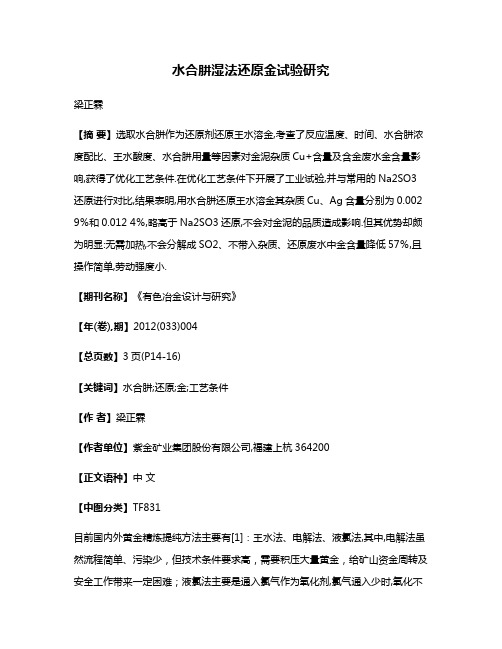
水合肼湿法还原金试验研究梁正霖【摘要】选取水合肼作为还原剂还原王水溶金,考查了反应温度、时间、水合肼浓度配比、王水酸度、水合肼用量等因素对金泥杂质Cu+含量及含金废水金含量影响,获得了优化工艺条件.在优化工艺条件下开展了工业试验,并与常用的Na2SO3还原进行对比,结果表明,用水合肼还原王水溶金其杂质Cu、Ag含量分别为0.002 9%和0.012 4%,略高于Na2SO3还原,不会对金泥的品质造成影响.但其优势却颇为明显:无需加热,不会分解成SO2、不带入杂质、还原废水中金含量降低57%,且操作简单,劳动强度小.【期刊名称】《有色冶金设计与研究》【年(卷),期】2012(033)004【总页数】3页(P14-16)【关键词】水合肼;还原;金;工艺条件【作者】梁正霖【作者单位】紫金矿业集团股份有限公司,福建上杭364200【正文语种】中文【中图分类】TF831目前国内外黄金精炼提纯方法主要有[1]:王水法、电解法、液氯法,其中,电解法虽然流程简单、污染少,但技术条件要求高,需要积压大量黄金,给矿山资金周转及安全工作带来一定困难;液氯法主要是通入氯气作为氧化剂,氯气通入少时,氧化不彻底,影响回收率,氯气通人多时,逸出的氯气对人体有害。
王水法具有操作简单、回收率高等优点得到广泛应用。
其工艺均采用王水溶金,再加入还原剂将金还原,或加入掩蔽剂络合干扰物质,再进行萃取提取。
因此,还原剂的选择尤为重要,直接决定了黄金提纯的质量和成本。
用于金氯酸溶液还原的还原剂种类很多[2,3]:有草酸、抗坏血酸、甲醛、氢醌、水合肼、二氧化硫、硫酸亚铁、亚硫酸钠等。
生产实践中根据金溶液中的含杂质情况选择还原剂种类,必要时选择还原能力强弱不同的两种或多种还原剂组合还原,以产生较佳还原效果。
目前工业主要使用亚硫酸钠作为还原剂进行还原。
但用亚硫酸钠作还原剂时需加热至75℃左右,耗费能源,在还原过程中还会产生大量SO2污染环境,且还原时相应的会引入少量的杂质,如钠离子在还原过程中生成相应的Na2SO4和NaCl等盐类,并进入金粉中影响金泥质量。
水合肼还原产物
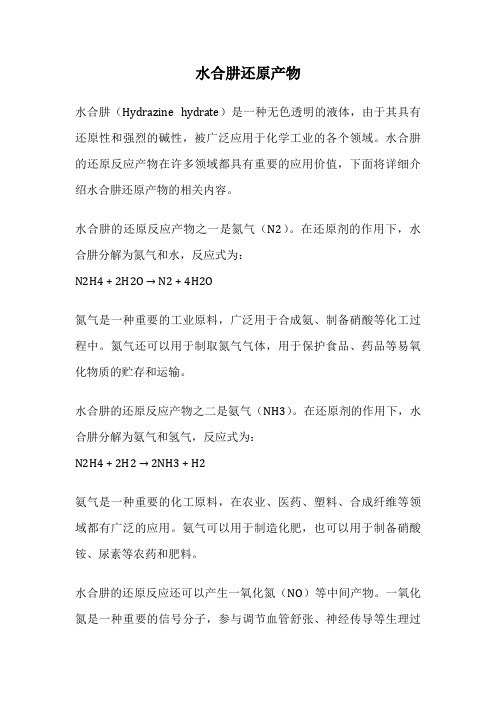
水合肼还原产物水合肼(Hydrazine hydrate)是一种无色透明的液体,由于其具有还原性和强烈的碱性,被广泛应用于化学工业的各个领域。
水合肼的还原反应产物在许多领域都具有重要的应用价值,下面将详细介绍水合肼还原产物的相关内容。
水合肼的还原反应产物之一是氮气(N2)。
在还原剂的作用下,水合肼分解为氮气和水,反应式为:N2H4 + 2H2O → N2 + 4H2O氮气是一种重要的工业原料,广泛用于合成氨、制备硝酸等化工过程中。
氮气还可以用于制取氮气气体,用于保护食品、药品等易氧化物质的贮存和运输。
水合肼的还原反应产物之二是氨气(NH3)。
在还原剂的作用下,水合肼分解为氨气和氢气,反应式为:N2H4 + 2H2 → 2NH3 + H2氨气是一种重要的化工原料,在农业、医药、塑料、合成纤维等领域都有广泛的应用。
氨气可以用于制造化肥,也可以用于制备硝酸铵、尿素等农药和肥料。
水合肼的还原反应还可以产生一氧化氮(NO)等中间产物。
一氧化氮是一种重要的信号分子,参与调节血管舒张、神经传导等生理过程。
一氧化氮还具有广泛的医学应用,可用于治疗心血管疾病、肺部疾病等。
除了上述产物外,水合肼的还原反应还可以产生氢氧化铵(NH4OH)等碱性产物。
氢氧化铵是一种常用的碱性试剂,可用于调节溶液的酸碱度,也可用于制备其他铵盐。
水合肼的还原反应产物包括氮气、氨气、一氧化氮和氢氧化铵等。
这些产物在化工、农业、医药等领域都有重要的应用价值。
水合肼作为一种重要的还原剂,其还原反应产物的研究和应用对于推动相关领域的发展具有重要意义。
希望通过对水合肼还原产物的研究和应用,能够进一步提高工业生产的效率,为社会的持续发展做出更大的贡献。
氯化银提取

氯化银的还原精炼方法至少有七十多种,但可概括为两大类:液相化学还原和高温熔炼还原法。
前者如水合肼(水合联氨)、甲酸、甲醛、葡萄糖、抗坏血酸、双氧水、硼氢化钠等还原方法及铁粉、锌粉、铝等金属置换法。
后者如碳酸钠、硼砂、碳、氢气高温还原法。
下面介绍几种较常见的还原法:1、水合肼还原法水合肼是强还原剂,水合肼可以直接还原氯化银。
氨水将氯化银络合生成银氨离子进入溶液。
氨浸条件:液固比3~4:1,室温,搅拌条件下加入氨水,在PH=9左右的条件下浸出2~3小时。
过滤后,渣用氨水与碳酸铵的混合液洗涤。
经一次氨浸处理,银的浸出率可达97%~98%。
向氨浸液中加入水合肼,还原条件:温度50摄氏度,水合肼用量为理论量的2~3倍,人工或机械搅拌下缓慢加入水合肼,30分钟左右即可。
还原率大于99%2、甲醛还原法在碱性溶液中,氯化银可被甲醛还原为金属银。
在搅拌下,用氢氧化钠调节氯化银水悬料PH至11,缓慢加入甲醛。
甲醛还原氯化银为放热反应,反应速度快。
必须用水反应洗涤海绵银中过剩的甲醛,以免熔炼铸锭时甲醛挥发中毒。
海绵银熔炼铸锭纯度大于99%3、硼氢化钠还原法用氢氧化钠调节氯化银水悬料PH至12.5,在60~80摄氏度时加入3%硼氢化钠,所得海绵银纯度大于99.9%4、锌粉还原向氯化银悬浮料中加入浓硫酸,到硫酸浓度约5%,边搅拌边向氯化银水悬浮料中缓慢加入锌粉,至无白色氯化银为止。
待反应完成后,再用5%稀硫酸溶解过剩的锌粉,用水反复洗涤PH到7。
1KG锌粉可还原4KG海绵银,得到粗银纯度为99.5%,锌置换母液含银0.0001g/L。
5、铁还原将氯化银放入容器中,并把铁片埋于氯化银沉淀中,再加浓盐酸淹盖,然后加热至沸腾,同时搅拌,至白色氯化银沉淀全变成灰色的银粉为止。
取出残余铁片,再用稀盐酸溶解残余的铁,用水反复洗涤PH到7。
海绵银熔炼铸锭纯度大于99%6、碳酸钠熔炼还原将干的氯化银和碳酸钠混合,氯化银:碳酸钠=1:0.4。
水合肼还原制备纳米铜粉的工艺优化
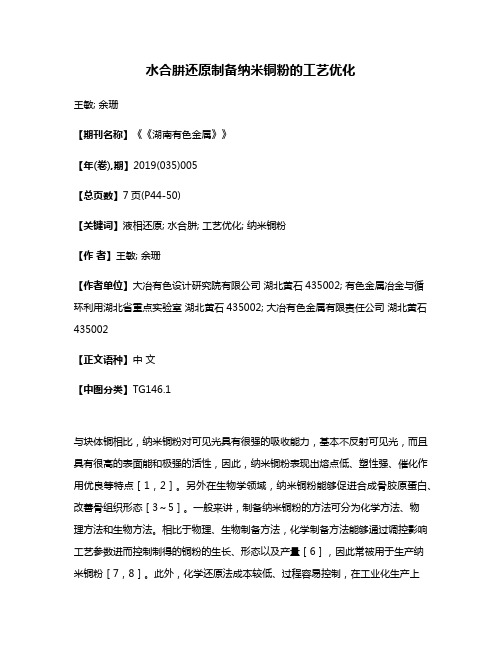
水合肼还原制备纳米铜粉的工艺优化王敏; 余珊【期刊名称】《《湖南有色金属》》【年(卷),期】2019(035)005【总页数】7页(P44-50)【关键词】液相还原; 水合肼; 工艺优化; 纳米铜粉【作者】王敏; 余珊【作者单位】大冶有色设计研究院有限公司湖北黄石435002; 有色金属冶金与循环利用湖北省重点实验室湖北黄石435002; 大冶有色金属有限责任公司湖北黄石435002【正文语种】中文【中图分类】TG146.1与块体铜相比,纳米铜粉对可见光具有很强的吸收能力,基本不反射可见光,而且具有很高的表面能和极强的活性,因此,纳米铜粉表现出熔点低、塑性强、催化作用优良等特点[1,2]。
另外在生物学领域,纳米铜粉能够促进合成骨胶原蛋白、改善骨组织形态[3~5]。
一般来讲,制备纳米铜粉的方法可分为化学方法、物理方法和生物方法。
相比于物理、生物制备方法,化学制备方法能够通过调控影响工艺参数进而控制制得的铜粉的生长、形态以及产量[6],因此常被用于生产纳米铜粉[7,8]。
此外,化学还原法成本较低、过程容易控制,在工业化生产上受到广泛关注[9,10]。
本文讨论化学还原法水合肼还原制备纳米铜粉过程中,反应温度、抗氧化剂添加量、PVP添加量、反应时间、体系pH值、铜盐浓度、还原剂的浓度等因素对铜颗粒的粒径与形貌的影响。
1 试验材料及方法1.1 试剂与仪器主要试剂:五水硫酸铜、水合肼、聚乙烯吡咯烷酮(以下简称PVP)、明胶,均为分析纯。
主要仪器:JOANLAB恒温磁力搅拌器(HSC-19T型)、台式高速离心机(TG16-WS型)、真空干燥箱(DZF型)、X-射线衍射仪(日本株式会理学公司Rigaku-TTRⅢ型)、扫描电子显微镜(日本电子公司的JSM-6360LV型)1.2 试验方法基本试验过程为:定量称取硫酸铜和聚乙烯吡咯烷酮(PVP)用100 mL去离子水溶于反应器中,再加入抗氧化剂,调节pH,配成溶液A。
水合肼还原金属铂的顺序

水合肼还原金属铂的顺序
水合肼是一种常用的还原剂,可以被用来还原金属铂。
在还原金属铂的过程中,水合肼会与铂离子发生反应,转化为铂的原子形式。
然而,水合肼在还原不同金属离子时的选择性有所不同。
对于铂来说,水合肼的还原能力较弱,因此需要使用较高浓度的水合肼溶液才能实现还原。
根据一般的实验经验,水合肼还原金属铂的顺序为:铂(IV) > 铂(II) > 铂(0)。
也就是说,水合肼首先还原四价铂离子(铂的氧化态为+4),然后再还原二价铂离子(铂的氧化态为+2),最后还原为纯铂金属。
需要注意的是,具体的反应条件(如温度、pH值等)和实验方法可能会对还原顺序产生影响。
在实际应用中,可以根据具体需求和实验条件进行调整。
水合肼还原产物
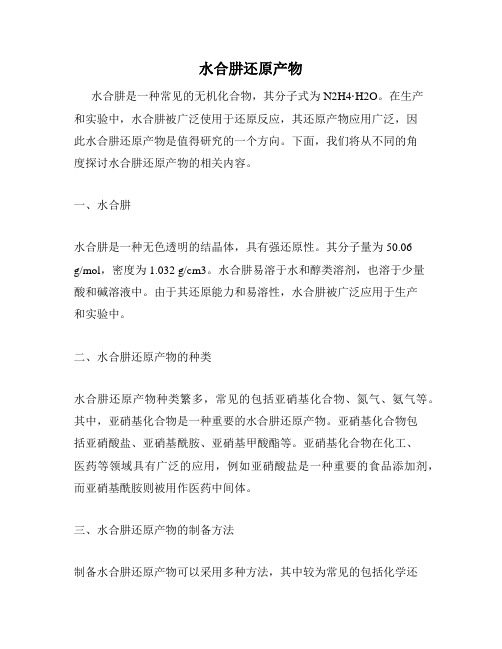
水合肼还原产物水合肼是一种常见的无机化合物,其分子式为N2H4·H2O。
在生产和实验中,水合肼被广泛使用于还原反应,其还原产物应用广泛,因此水合肼还原产物是值得研究的一个方向。
下面,我们将从不同的角度探讨水合肼还原产物的相关内容。
一、水合肼水合肼是一种无色透明的结晶体,具有强还原性。
其分子量为50.06g/mol,密度为1.032 g/cm3。
水合肼易溶于水和醇类溶剂,也溶于少量酸和碱溶液中。
由于其还原能力和易溶性,水合肼被广泛应用于生产和实验中。
二、水合肼还原产物的种类水合肼还原产物种类繁多,常见的包括亚硝基化合物、氮气、氨气等。
其中,亚硝基化合物是一种重要的水合肼还原产物。
亚硝基化合物包括亚硝酸盐、亚硝基酰胺、亚硝基甲酸酯等。
亚硝基化合物在化工、医药等领域具有广泛的应用,例如亚硝酸盐是一种重要的食品添加剂,而亚硝基酰胺则被用作医药中间体。
三、水合肼还原产物的制备方法制备水合肼还原产物可以采用多种方法,其中较为常见的包括化学还原法、电化学还原法和光化学还原法等。
其中,化学还原法是一种常见的制备亚硝基化合物的方法,该方法主要是利用水合肼的还原性将有机化合物还原为相应的亚硝基化合物。
电化学还原法则是利用电化学作用将水合肼还原,生成相应的还原产物。
光化学还原法则是利用光照作用将水合肼还原,生成相应的还原产物。
四、水合肼还原产物的应用水合肼还原产物应用广泛,例如亚硝酸盐可以用作食品添加剂、防腐剂等。
亚硝基酰胺则被广泛用作医药中间体,如合成头孢菌素等。
此外,水合肼还原产物还可以作为化学试剂,如亚硝酸盐可以用作标准物质和化学分析试剂。
总之,水合肼还原产物是一种值得研究的化学话题。
通过了解水合肼的化学性质、还原产物的种类、制备方法以及应用领域,有助于更好地掌握水合肼的应用价值,推动其在相关领域的研究和应用。
水合肼还原容量法测定阳极泥中的硒
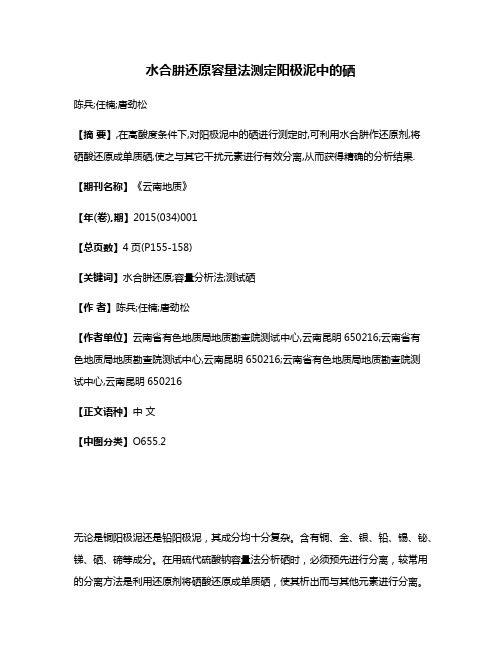
水合肼还原容量法测定阳极泥中的硒陈兵;任楠;唐劲松【摘要】,在高酸度条件下,对阳极泥中的硒进行测定时,可利用水合肼作还原剂,将硒酸还原成单质硒,使之与其它干扰元素进行有效分离,从而获得精确的分析结果.【期刊名称】《云南地质》【年(卷),期】2015(034)001【总页数】4页(P155-158)【关键词】水合肼还原;容量分析法;测试硒【作者】陈兵;任楠;唐劲松【作者单位】云南省有色地质局地质勘查院测试中心,云南昆明650216;云南省有色地质局地质勘查院测试中心,云南昆明650216;云南省有色地质局地质勘查院测试中心,云南昆明650216【正文语种】中文【中图分类】O655.2无论是铜阳极泥还是铅阳极泥,其成分均十分复杂。
含有铜、金、银、铅、锡、铋、锑、硒、碲等成分。
在用硫代硫酸钠容量法分析硒时,必须预先进行分离,较常用的分离方法是利用还原剂将硒酸还原成单质硒,使其析出而与其他元素进行分离。
常用的还原剂有盐酸羟胺[1]、硫脲[1]等。
但碲含量比硒含量高时,两者分离不完全。
提高酸度时,碲不还原,而难与硒分离,但在高酸度时,如何使硒较完全还原,笔者经研究发现,利用水合肼作还原剂,在约7mol/L盐酸介质中,可以使硒完全沉淀,而碲不沉淀,从而获得较好的硒分离效果。
硫代硫酸钠标准溶液(0.1mol/L):称取25g硫代硫酸钠(Na2S2O3.5H2O)置于500 mL烧杯中,用煮沸冷却后的蒸馏水溶解,移入1 000mL容量瓶中,用上述蒸馏水稀释至刻度,摇匀。
1~2日后标定。
标定:称取0.1000g硒(99.999%)于300mL锥形瓶中,加入15mL盐酸和0.5mL 硝酸,置水浴上加热至硒完全溶解,加入2g脲、80mL水,继续水浴上加热20分钟。
取下,流水冷却,以酚酞作指示剂,用20%氢氧化钠中和至碱性。
再加20mL硫酸(1+1),冷却后,用硫代硫酸钠滴定至近中点,加入2mL 5%碘化钾、5mL 0.5%淀粉,继续滴定至蓝色消失为终点。
- 1、下载文档前请自行甄别文档内容的完整性,平台不提供额外的编辑、内容补充、找答案等附加服务。
- 2、"仅部分预览"的文档,不可在线预览部分如存在完整性等问题,可反馈申请退款(可完整预览的文档不适用该条件!)。
- 3、如文档侵犯您的权益,请联系客服反馈,我们会尽快为您处理(人工客服工作时间:9:00-18:30)。
Application of hydrazinium monoformate as new hydrogen donor with Raney nickel:a facile reduction of nitro and nitrile moietiesShankare Gowda and D.Channe Gowda pDepartment of Studies in Chemistry,University of Mysore,Manasagangotri,Mysore,Karnataka570006,IndiaReceived26September2001;revised18December2001;accepted17January2002AbstractÐThe nitro groups in aliphatic and aromatic nitrocompounds also containing reducible substituents such as ethene,acid,phenol, halogen,ester etc.,are rapidly reduced at room temperature to corresponding amines by employing hydrazinium monoformate,a new hydrogen donor,in the presence of Raney nickel.It was observed that the nitrile function also undergoes reduction to methylamine(±CH2±NH2).Hydrazinium monoformate is a more effective donor than hydrazine or formic acid and reduction of nitro and nitrile groups occurs without hydrogenolysis in the presence of low cost Raney nickel,compared to expensive metals like palladium,platinum or ruthenium.The reduction is reasonably fast,clean and high yielding.q2002Elsevier Science Ltd.All rights reserved.1.IntroductionRapid and selective reduction of nitrocompounds is of importance for the preparation of amino derivatives in organic synthesis,both practically and industrially,particu-larly when a molecule has other reducible moieties.1±4 Numerous new reagents have been developed for the reduction of aromatic nitrocompounds.5±12However,little attention has been given to the reduction of aliphatic nitro-compounds,13±15which are traditionally reduced by high-pressure catalytic hydrogenation.10,16,17Most of the methods,viz.,metal/acid reduction,18catalytic hydrogena-tion,19electrolytic reduction,20homogeneous catalytic transfer hydrogenation,21heterogeneous catalytic transfer hydrogenation,22etc.,are in practice.However,these methods have one or more limitations:(i)metal/acid system lacks selectivity and requires strong acid medium.(ii) Catalytic hydrogenation employs highly diffusible,low molecular weight,¯ammable hydrogen gas and requires pressure equipment.(iii)Electrolytic reduction requires acidic or alkaline catholite,yields are low and lack practical utility in academic institutions.(iv)Homogeneous catalytic transfer hydrogenation requires expensive complexes as catalysts;work up and isolation of the products are not easy.(v)Heterogeneous catalytic transfer hydrogenation employs expensive bulk or supported metals like palladium, platinum,ruthenium etc.,and these supported catalysts require stringent precautions,because of their¯ammable nature in the presence of air.Raney nickel is routinely used as a catalyst in the®eld of catalytic hydrogenation19,23as well as in the®eld of hetero-geneous catalytic transfer hydrogenation.2,12,24±29It is used for the selective reduction of nitrocompounds,dinitro substituted diphenylsulfones,O-and N-benzyl containing nitrocompounds,for the conversion of nitro ole®ns into car-bonyl derivatives,30and for the synthesis of halo amines from halo nitrocompounds.In all these cases,the commonly used hydrogen donors are hydrazine hydrate,ammonium formate,formic acid and cyclohexene.Further,the use of hydrazine derivatives like methyl hydrazine,31unsymmetri-cal dimethyl hydrazine,31phenyl hydrazine,32and triethyl-ammonium formate in the presence of various metals are also in practice,but not hydrazinium monoformate.In this communication,we wish to report a rapid and simple reduction of aliphatic and aromatic nitrocompounds,and nitriles to the corresponding amino derivatives by using Raney nickel and hydrazinium monoformate,a new hydrogen donor,at room temperature(Scheme1).This new system reduced with ease a wide variety of nitro and nitrile compounds directly to the corresponding amines and many functional groups are tolerated.Hydrazinium monoformate is soluble in solvents like methanol,ethanol,Pergamon0040±4020/02/$-seefront matter q2002Elsevier Science Ltd.All rights reserved.PII:S0040-4020(02)00093-5Scheme1.R alkyl or aryl residue substituted with±OH,OR,±CO2H,±CO2R,±CONH2,±NHCOCH3,etc.Keywords:hydrazinium monoformate;Raney nickel;catalytic transfer hydrogenation;nitrocompounds;nitriles;reduction;new hydrogen donor. p Corresponding author.Tel.:191-0821-515525,ext.48;191-0821-344348;fax:191-0821-421263;191-0821-518835;e-mail:dcgowda@S.Gowda,D.C.Gowda/Tetrahedron58(2002)2211±2213 2212tetrahydrofuran,dimethylformamide and glycols.But with solvents like dichloromethane,chloroform,benzene,etc.,it forms a biphasic system and in this system,the reactions are rather slow.This system cannot be employed with ketonic and nitrile solvents,as it forms hydrazones with former and reduces the latter.Our main intention was to reduce nitrocompounds selectively to the corresponding amines.But surprisingly, we observed that this system reduced nitriles to methyl-amines,unlike the reduction of a nitrile group to methyl group,using10%Pd±C/HCOONH4.33,34In the case of nitro nitriles,the two moieties are reduced to an amino group and a methylamine group,respectively.This system is not helpful to directly obtain an amino carbonyl compound,due to the formation of a hydrazone derivative with the donor.However,the nitro hydrazones are reduced to the corresponding amino hydrazines by this system. Further,hydrazinium monoformate/Raney nickel system is more effective than either triethylammonium formate/5% Pd±C35or cyclohexene/10%Pd±C36or hydrazine hydrate/ Fe(III)37and equally compatible with the systems like HCOONH4/10%Pd±C,1HCOONH4/5%Pt±C11and HCOONH4/Raney Ni.12Though ammonium formate is extensively used in the®eld of catalytic transfer hydrogena-tion,it is sparingly soluble in solvents such as methanol;but hydrazinium monoformate is freely soluble in`methanol-like'solvents.Therefore,this system may®nd its own appli-cation in the®eld of catalytic transfer hydrogenation. The reduction of nitro aromatic compounds in the presence of Raney nickel and hydrazinium monoformate was complete within2±10min.The course of reaction was monitored by thin layer chromatography(t.l.c.)and IR spectra.The work-up and isolation of the products were easy.Thus,all the compounds reduced(Table1)by this system were obtained in good yields(90±95%).All the products were characterized by comparison of their t.l.c., IR spectra and melting points with authentic samples.A control experiment was carried out using nitrocompounds with hydrazinium monoformate but without Raney nickel, does not yield the desired product.The t.l.c.and IR spectra could not detect any intermediates such as nitroso or hydroxylamine in the reaction mixture after the completion of reaction.Since the reaction is so fast(2min),the detec-tion of intermediates is not possible.In order to test the selectivity,the reduction was attempted with p-dichloro-benzene,p-chloro-m-cresol,b-naphthol,cinnamic acid, acetanilide,benzoic acid,anisole,phenyl acetate,etc.,at laboratory temperature.However,the reaction failed to give any reduced product.Further,it was observed that hydrazinium monoformate is a more effective donor than either hydrazine or formic acid in the presence of Raney nickel.The reduction was completed within2±6min with the present system.The methods reported earlier for the reduction of nitro arenes to amino arenes by using Raney nickel and hydrazine requires longer reaction time as long as 2±10h at re¯ux temperature24,26,28,29and Raney nickel/ formic acid system needs20±30min for the completion of reduction.12Furthermore,both the systems are unable to reduce nitrile function.Thus,the reduction of nitro-compounds and nitriles can be accomplished with Raney nickel instead of expensive platinum,palladium etc., without effecting the reduction of any reducible orTable1.Reduction of nitrocompounds and nitriles using hydrazinium monoformate/nickelNitro or nitrile compounds.Reaction time(in min)Product Yield a(%)Melting point(8C)Found Lit.m-Nitrophenol2m-Aminophenol94121±12312338o-Nitrotoluene3o-Toluidine b93142±14414438p-Nitrotoluene2p-Toluidine9444±454538a-Nitronaphthalene2a-Naphthylamine9250±515038p-Nitroanisole2p-Anisidine9556±575738m-Nitroaniline3m-Phenylenediamine9464±656438m-Nitrobenzyl alcohol3m-Aminobenzyl alcohol9196±989738p-Nitrobenzamide3p-Aminobenzamide92115±11611438p-Nitrophenyl acetate3p-Aminophenylacetate c93148±15115038m-Nitrobenzoic acid3m-Aminobenzoic acid94174±17617438m-Nitrochloro benzene3m-Chloroaniline b92120±12312238m-Nitrobromo benzene3m-Bromoaniline b94118±12112038p-Nitrocinnamic acid3p-Aminocinnamic acid d90265±268265-27039 p-Nitroacetanilide3p-Aminoacetanilide93163±16516338 Nitromethane2Methylamine d80230±233232±23439 Nitroethane2Ethylamine d81106±108107±10839 1-Nitropropane21-Aminopropane d84158±160160±16239 1-Nitrobutane31-Aminobutane7578±80e7838 Acetonitrile3Ethylamine d75106±108105±10639 Propiononitrile3n-Propylamine d76158±160159±16039 Benzonitrile5Benzylamine b80105±10810538 Phenylacetonitrile52-Phenylethylamine b80115±11811638p-Chlorobenzonitrile6p-Chlorobenzylamine7088±909038m-Methoxybenzonitrile6m-Methoxybenzylamine72110±11211038a Isolated yields are based on single a experiment and the yields were not optimised.b Isolated as benzoyl derivative.c Isolated as acetyl derivative.d Isolated as hydrochloride salt.e Boiling point at710mm.S.Gowda,D.C.Gowda/Tetrahedron58(2002)2211±22132213hydrogenolysable substituents except the nitrile group.The yields are virtually quantitative and the compounds obtained are analytically pure.The obvious advantages of the proposed method over previous methods are:(i)selective reduction of nitro and nitrile compounds,in the presence of other reducible or hydrogenolysable groups,(ii)easy to operate,(iii)rapid reduction,(iv)high yields of substituted amines,(v)avoidance of strong acid media,(vi)no require-ment for pressure apparatus and(vii)inexpensive.This procedure will therefore be of general use,especially in the cases where rapid,mild and selective reduction is required.Further investigations of other useful applications related to the deblocking of protecting groups in peptide synthesis are in progress.2.ExperimentalHydrazinium monoformate was prepared by slowly neutralizing equal moles of hydrazine hydrate and85% formic acid in an ice water bath,with constant stirring. The hydrazinium monoformate solution thus obtained was used as such for reduction.A suspension of an appropriate nitrocompound or nitrile(5mmol)and Raney nickel (100mg)in methanol or in any suitable solvent(3mL) was stirred under nitrogen atmosphere with hydrazinium monoformate(2mL),at room temperature.The reaction was exothermic and effervescent.After the completion of reaction(monitored by t.l.c.),the reaction mixture was ®ltered through celite.The organic layer was evaporated and the residue was dissolved in chloroform or dichloro-methane or ether was washed with saturated sodium chloride solution to remove excess of hydrazinium mono-formate.The organic layer after drying and evaporation gave the desired amino derivative.In order to get a good yield of volatile aliphatic amines,the reaction was carried out by controlled addition of hydra-zinium monoformate,through the top of a condenser circulated with ice water and by immersing the reaction ¯ask in a cold-water bath.After®ltration,the whole reaction mixture was neutralized with HCl.The solvent was evapo-rated under reduced pressure.The residue was lyophilized or subjected to column chromatography.Aliphatic amines were obtained as their hydrochloride salts up to80%yield.References1.Ram,S.;Ehrenkaufer,R.E.Tetrahedron Lett.1984,25,3415.2.Yuste,F.;Saldana,M.;Walls,F.Tetrahedron Lett.1982,23,147.3.Lyle,R.E.;LaMattina,J.L.Synthesis1974,726.4.Ho,T.L.;Wang,C.M.Synthesis1974,45.5.Baik,W.;Han,J.L.;Lee,K.C.;Lee,N.H.;Kim,B.H.;Hahn,J.T.Tetrahedron Lett.1994,35,3965.6.Prajapathi,D.;Borah,H.N.;Sandhu,J.S.;Ghosh,A.C.mun.1995,25,4025.7.Banik,B.K.;Barakat,K.J.;Wagle,D.R.;Manhas,M.S.;Bose,.Chem.1999,64,5746.8.Akita,Y.;Inaba,M.;Uchida,H.;Ohta,A.Synthesis1977,792.9.Borah,H.N.;Prajapathi,D.;Sandhu,J.S.;Ghosh,A.C.Tetrahedron Lett.1994,35,3167.10.George,J.;Chandrashekaran,mun.1983,13,495.11.Gowda,D.C.;Mahesha,mun.2000,30,3639.12.Gowda,D.C.;Gowda,A.S.P.;Baba,A.R.;Gowda,S.Synth.Commun.2000,30,2889.13.Akita,A.;Inaba,M.;Uchida,H.;Ohta,A.Synthesis1977,792.14.Borah,H.N.;Prajapathi,D.;Sandhu,J.S.;Ghosh,A.C.Tetrahedron Lett.1994,35,3163.15.Romas,M.N.;Srivastva,R.M.;Brito,M.B.;De Sa,G.F.J.Chem.Res.(S)1984,228.16.Finkbeiner,H.L.;Stiles,M.J.Am.Chem.Soc.1963,85,616.17.Stiles,M.;Finkbeiner,H.L.J.Am.Chem.Soc.1959,81,505.18.House,H.O.Modern Synthetic Reactions;2nd ed;Benjamin:New York,1977;p145.19.Rylander,P.N.Hydrogenation Methods;Academic:NewYork,1985;p365.20.Popp,F.D.;Schultz,H.P.Chem.Rev.1962,62,19.21.Harmon,R.E.;Gupta,S.K.;Brown,D.J.Chem.Rev.1972,72,21.22.Johnson,R.A.W.;Wilby,A.H.;Entwistle,I.D.Chem.Rev.1985,85,129.23.House,H.O.Modern Synthetic Reactions;2nd ed;Benjamin:New York,1977;pp1±44.24.Balcom,D.;Furst,A.J.Am.Chem.Soc.1953,75,4334.25.Moore,R.E.;Furst,.Chem.1958,23,1504.26.Brown,R.K.;Nelson,N.A.J.Am.Chem.Soc.1954,76,5149.27.Furst,A.;Moore,R.E.J.Am.Chem.Soc.1957,79,5492.28.Leggeter,B.E.;Brown,R.K.Can.J.Chem.1960,38,2363.29.Ayyanger,N.R.;Lugade,A.G.;Nikrad,P.V.;Sharma,V.K.Synthesis1981,640.30.Monti, D.;Gramatica,P.;Speranza,G.;Mannito,P.Tetrahedron Lett.1983,24,147.31.Furst,A.;Berlo,R.C.;Hooton,S.Chem.Rev.1965,65,51.32.Ochini,E.;Mitarashi,H.Chem.Pharm.Bull.,Tokyo1963,11,1084.33.Brieger,G.;Nestrick,T.J.Chem.Rev.1974,74,67.34.Brown,G.R.;Foubister,A.J.Synthesis1982,1036.35.Cortese,N.A.;Heck,.Chem.1977,42,3491.36.Entwistle,I.D.;Johnstone,R.A.W.;Povall,T.J.J.Chem.Soc.,Perkin Trans.11975,1300.37.Hirashima,T.;Manabe,O.Chem.Lett.1995,259.38.Vogel,A.I.In Text Book of Practical Organic Chemistry;Furniss,B.S.,Hannaford,A.J.,Smith,P.W.G.,Tatchell,A.R.,Eds.;5th ed,Addison-Wesely/Longman:UK,1997;pp1298±1398,Chapter10.39.The Merck Index;Budavari,S.,Ed.;11th ed,Merck:Rahway,NJ,1989;p3247.。
